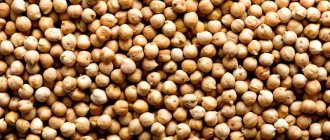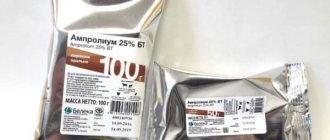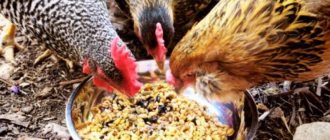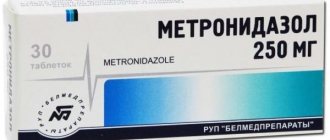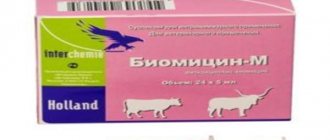2 173
2 comments
3
Author of the article
Sadchikov Nikolay Alekseevich
Reading time: 2 minutes
Type of drug - antimicrobial and antiprotozoal.
Release form: tablets.
Used for diseases: coccidiosis, trichomoniasis, histomoniasis.
Analogues of the drug: metroxan, trichosept, rosex, metrovit.
Cost of the drug: tablets 250 pcs. per package - from 300 to 420 rubles.
The active ingredient of the drug has the same name - metronidazole. , etc. After ingestion by bacteria and protozoa, the drug molecules react with the transport proteins of these organisms. As a result, the drug enters into active communication with the DNA cells of microorganisms and blocks the ability of them to synthesize protein, which prevents them from reproducing and leads to death.
After administration, the active substance enters the digestive system, from where it is absorbed into organs and tissues. The drug accumulates in the liver.
Metronidazole is completely eliminated from the body after 8 hours. The main part of the substance (60-80%) is excreted by renal filtration, the remaining part leaves the body with feces.
Form, composition
The main component in Metronidazole is an antimicrobial and antiprotozoal component, which bears the same name.
In addition, the composition includes various ballast substances, glucose and chemical compounds, the purpose of which is to facilitate the absorption of the drug into the blood and ensure maximum penetration directly into the bloodstream.
Among the dosage forms in which Metronidazole is produced, there are those that are not suitable for consumption by poultry - suppositories, ointments, toothpastes.
Tablets and capsules are considered the most suitable for laying hens. The weight of the tablet is most often 500 mg, and the amount of active ingredient is 0.125 or 0.250 g.
The number of pills in the package may vary depending on the country of origin. Most often, the drug is produced packaged in 10, 20, 50, 100, 250, 500 and 1,000 tablets in cans or boxes.
Since Metronidazole is a drug, before giving it to birds, you should consult with a veterinarian, who will make a diagnosis and determine how much medication to take.
Treatment methods for chickens
The arsenal of tools used is quite extensive. The most popular of them remain the following compositions:
- chloramphenicol. Used in the fight against salmonellosis. The dose is 30-50 mg/kg body weight, three times a day;
- Coccidin. From the name it is clear that it is taken to treat diarrhea caused by coccidiosis. Over the course of 3-5 days, 250 mg of this powder is added to 1 kg of feed, after which the dose is reduced to 125 (this rate is maintained for another week). Analogues of the drug - Zolen and Sulfadimezin;
- Furazolidone. His “specialization” is the treatment of pullorosis and pasteurellosis. Dosage depends on age. For example, 0.02 mg is added to the feed for chickens up to 10 days old (this is for 10 birds), while two-week-old young animals already need 0.03 mg. The adult norm is 0.04 mg;
- metronidazole for histomoniasis. Added to feed for 5 days (20-25 mg/kg live weight);
- "Biomycin". This is the most universal remedy. It is diluted in water at the rate of 1 mg/1 l or administered intramuscularly (2-3 mg per 2-cc syringe with water).
All these drugs are used to treat infectious diseases and are strictly prescribed by a veterinarian. He also adjusts the dosage according to the situation.
It is somewhat easier to cure diarrhea caused by an incorrect diet - it is revised, removing the ingredients that caused such complications. There are also some nuances here.
For the treatment and prevention of histomoniasis in birds, Trichopolum is mixed with food. For 1 kg of feed you need to add 150 mg of trichopolum. Give to sick chickens once a day for ten days.
If chickens are sick with coccidiosis, then you need to dilute the drug in water at the rate of 0.1 g per 1 kg of chick weight. Drink into the beak for 10 days, three times a day.
To treat trichomoniasis in chickens, Trichopolum is diluted at the rate of 25-50 mg per 1 kg of chick weight, given for two days in a row, and repeated after a week. To wash the eyes and nose in the presence of discharge, use a 0.1% solution of trichopolum.
Trichopolum is an effective modern drug for the treatment of young chickens. If used correctly and treatment started on time, it can help stop the disease and save the poultry population.
Since it is impossible to monitor everything that birds eat, especially in free-ranging birds, one of the most common diseases is diarrhea in laying hens. We offer information on how to treat it.
Keeping an eye on the litter
The consistency, color and frequency of bowel movements are all important. If you want to raise a healthy bird, this issue must be constantly kept under control, and in no case should it be left to chance.
Intestinal
Daytime bowel movements are called bowel droppings. In a healthy chicken, they should be dark or light brown in color and shaped like granules.
If the bird's stool does not meet these characteristics, further observation should be made to establish a diagnosis.
Caecal
Night droppings are called caecal droppings, and their normal consistency is much thinner than intestinal droppings, and the color should be dark brown.
1 1 1 1 1 1 1 1 1 1 4.90 (down: 5)Treatment of diarrhea in chicken - 4.8 5 5 votes
Breeding chickens is not only about reliable, guaranteed quality food products in the form of eggs and meat. These are systematic efforts for proper maintenance, careful care, and timely treatment of diarrhea in broiler feeders.
Good afternoon, dear readers of the site about hens and cockerels. Additional income for a family from breeding and feeding a family of chickens requires constant vigilance.
It is much easier to purchase seeds in bulk and sell them in your region, dacha cooperative or gardening partnership. After all, seeds and planting material do not get sick! And chickens and chickens can get sick.
Fluffy yellow lumps that have just hatched from eggs are too delicate to immediately adapt to environmental conditions that are not always pleasant. It’s not for nothing that they say: chickens are counted in the fall.
Many chicks die in the first week, and some more in the next month. Only the strongest and those that have been carefully looked after will remain.
Treatment of diarrhea in chickens
The first signs of illness in a chicken are its unkempt appearance: the fluff falls off, loses its sunny yellow color, turns gray, and collects dirt. The chick is weak on its legs and staggers when moving.
Such a pet should be checked for infection with diarrhea - make sure that it is not diarrhea. The correct symptoms are that the chicken has liquid, frequent droppings around the anus. So the chick is not far from dehydration, and then from death.
There are many reasons why chickens have diarrhea. This includes hypothermia from drafts, wet paws, bedding changed at the wrong time, and inadequate heating. The first step is to find out and eliminate the cause, then the diarrhea will go away.
Pharmacological properties
Metronidazole affects most protozoan parasites - Trichomonas, Histomonas, amoebas and a number of others. After ingestion by bacteria and protozoa, the drug molecules react with the transport proteins of these organisms.
As a result, the drug enters into active communication with the DNA cells of microorganisms and blocks the ability of them to synthesize protein, which prevents them from reproducing and leads to death.
After taking Metronidazole, it enters the digestive system, from where it spreads through the tissues of the organs. It tends to accumulate in the liver. The half-life is about 8 hours.
Most of Metronidazole leaves the body by renal filtration (60-80%), and the rest is excreted in the feces. The elimination of metabolites that appear in the liver takes a little longer.
Treatment of coccidiosis in broilers
Today, poultry farmers have at their disposal a number of products that, when added to poultry feed, quickly stop the proliferation of coccidia. When prescribing therapy, adhere to the fact that the drug chosen for treatment, prevention and prevention of death of broilers:
- should not accumulate in the body of birds;
- cannot be toxic to birds or humans;
- does not have a negative impact on the development and growth of young animals;
- does not cause addiction in birds;
- can be given with food, but does not change its taste and does not lose its effect.
Broilers with coccidiosis are prescribed cocciprodine, which destroys the structure of the causative agent of the disease and stops the development of coccidia. This drug is diluted in water according to the dosage indicated in the annotation. The birds are given a medicinal drink for two days, and in particularly difficult situations, after five days the broilers are again given water with cocciprodine.
The use of Avatek 15% CC by birds also leads to the death of pathogens. The chemical composition is not absorbed into the intestines and is excreted from the body, acting only on harmful protozoa. Therefore, Avatek is given almost from the first days until 4 months of age. When symptoms of coccidiosis are confirmed, for the treatment of broilers the drug is mixed with food at the rate of 5 grams per 10 kg of feed mixture.
One of the popular means of combating and preventing coccidiosis is Baycox. This remedy is also given with drinking water, adding 1 ml per liter of liquid, and fed to sick broilers for two days. The course is repeated in case of severe disease.
Medicines such as Coccidiovit and Madicox, which are effective against coccidiosis in broilers, are also added to the feed. Amprolium 30% is more versatile and can be added to both water and poultry feed.
In some cases, broad-spectrum drugs are used to treat this terrible disease. An example is metronidazole added to feed; its dosage for broiler chickens should be prescribed by a veterinarian, since thoughtless use of the drug, especially at an early age, can harm the bird. Trichopolum has a similar, broad effect, which is more convenient to administer in a drink.
Purpose, indications for use
The essence of taking Metronidazole is to remove protozoan parasites and anaerobic microorganisms from the body.
Coccidiosis
This is a protozoonotic infectious disease caused by protozoan anaerobic bacteria - Eimeria. They develop and affect the organs of the gastrointestinal tract in the first days of life. It is impossible to completely cure this disease.
Trichomoniasis
It is the most dangerous infection among chickens. It is especially dangerous for broilers, as they have weak, poorly developed immunity.
But still, they do not encounter this disease as often as backyard birds, since broiler birds do not have contact with the carriers of trichomoniasis - pigeons.
In addition, the sources of infection are usually dirty water and chicken feed, and the causative agent is Trichomonas. To prevent infection, it is recommended to keep your water and food clean.
Histomoniasis
It is an invasive disease caused by the simplest anaerobic bacterium, histomonas. The disease occurs as a result of non-compliance with the rules of keeping poultry and poor feeding. Characterized by damage to the cecum and liver.
If you observe the following symptoms of disease in chickens:
- bloody diarrhea;
- lack of appetite;
- thirst for drink;
- inactivity;
- flocking;
- desire for warmth
then this indicates that it is urgently necessary to resort to treatment with Metronidazole.
Reception features
Coccidiosis
When a bird is affected by this disease, the following symptoms are observed::
- poor appetite;
- increased desire to drink;
- inactivity;
- diarrhea with blood clots;
- the chicken tries to stay away from its relatives;
- chicks are concentrated near a heat source;
- paralysis.
Description with photos of diseases of phalaenopsis and other orchids (leaves, roots, flower buds, peduncles) and their treatment || Description with photos of diseases of phalaenopsis and other orchids (leaves, roots, flower buds, peduncles) and their treatment
Metronidazole can be used for the treatment and prevention of this pathology. If for treatment, then the drug is given in a dosage of 0.1 g of the main substance per 1 kg of bird weight . Thus, 1 tablet is enough for 5 kg of chicken.
The required dosage of powder or tablet must be diluted in water, and the solution must be injected into the chick’s beak with a pipette or syringe. Take Metronidazole once a day. Duration of therapy is 1.5 weeks.
If Metronidazole is given as a prophylaxis, it should be mixed with food in an amount of 0.2-0.25 g per 1 kg of chick. Prevention of coccidiosis can last 1.5 months.
Histomoniasis
When chicks are affected by histomoniasis, the following symptoms are observed::
poor appetite;
- inactivity;
- yellow foamy diarrhea;
- wing curling;
- the chick tries to stay away from its fellows;
- feathers are dirty;
- the skin on the head is blue.
This disease can affect chickens from 20 to 90 days of life . In adult birds, histomoniasis is extremely rare. If you use Metronidazole to treat a disease, then 0.25 g of the drug is consumed per 1 kg of weight.
Dilute it in water and give it through a syringe 3 times a day for a week. Powder or crushed tablets can be added to food. For 1 kg of food 4.5 g Metronidazole. Divide into 3 doses. The course of therapy is 10 days.
Instructions for use in veterinary medicine
Broiler chickens
When breeding broiler chickens, this antibiotic can be used both for prevention and for targeted treatment of histomoniasis or coccidiosis.
These diseases affect the digestive system of young animals immediately after birth, causing focal inflammation, which without adequate therapy can lead to complete liver damage.
Then the cost of feeding will increase or partial or complete extinction of the livestock may occur.
Symptoms of coccidiosis include:
- Significant decrease in appetite.
- Pathological increase in fluid intake in young animals.
- Loss of activity in chickens, they accumulate in heaps.
- Chicks tend to roost closer to the warmth.
- The disheveled youngsters sit with their hair ruffled and express apathy towards the world around them.
- Diarrhea with blood is present.
- In some cases, partial or complete paralysis is observed.
To prevent this disease, special treatments are carried out on broiler chicken every 14 days until the chickens are 1.5 months old.
Metronidazole is added to food in a proportion of 20–25 mg per 1 kg of live weight for 5 days.
It should not be added to water, since it is not so effective and therefore impractical: the powder does not dissolve in the liquid, but remains in it as sediment at the bottom of the drinkers.
For chickens
If trichomoniasis is detected, the birds begin immediate treatment by adding the drug “Trichopol” at a dosage of 3 g per 1 liter of drinking water.
To clean the oral cavity of secretions and subsequent instillation, change the concentration of the solution - 17 g of the drug is dissolved in a liter of water.
The plaque is removed using a tampon soaked in a medicinal preparation. Medical measures must be carried out within 1 week.
To prevent this disease, contact between chickens and pigeons should be excluded (almost 100% of pigeons are carriers of the infection), sick birds are urgently removed from the chicken coop, the room and all surfaces of which are thoroughly disinfected.
In addition, it is important to support the immunity of poultry with vitamin complexes, introducing them into the diet.
Turkey poults
When turkey poults are raised, metronidazole is used for preventive and therapeutic purposes to combat such a dangerous disease as histomoniasis, which can destroy all young animals.
Young animals are susceptible to this disease, mainly from 2 weeks of age. From the beginning of infection in the body, turkey poults begin to develop inflammation of the cecum and liver.
If appropriate measures are not taken, then without the necessary treatment the disease progresses, leading the chicks to extreme exhaustion and ultimately death.
Symptoms of histomoniasis:
- Poor appetite, in severe forms – lack of appetite.
- The chicks are depressed and inactive.
- The wings are relaxed and drooped, the down is dirty or tousled.
- The birds suffer from diarrhea with foamy, bright yellow diarrhea.
- In some cases, the skin on the head turns blue, and therefore this disease is popularly called “black head”.
Metronidazole can be given to turkey poults both for prophylaxis and directly for therapy. The doses in the first and second cases will differ.
For prevention purposes, the tablets are ground into powder and placed in the feed at a dosage of 20 mg per kg of bird weight. The course of treatment is 3–5 days.
The therapeutic dose for turkey chicks should be greater, at least 25 mg per kg of weight. The course of treatment is about 7 days.
Goslings
Metronidazole is also used both as a disease prevention and for treatment when raising goslings. These birds are susceptible to diseases such as histomoniasis or trichomoniasis.
These diseases involve various severe disorders of not only the traditional digestive system, but also the respiratory system. The young eventually die from exhaustion or suffocation.
The main symptoms of trichomoniasis:
- Yellowish coating in the larynx;
- Hypothermia;
- Goslings don't eat;
- General depression;
- Foul, yellowish-gray diarrhea;
- Increased goiter;
- Difficulty breathing;
- Choking with discharge from eyes and nose;
The duration of the disease can be 1.5–2 weeks. The death rate of goslings from this disease can be up to 90%.
To cure chicks, metronidazole is ground into powder and added to food at the rate of 25 mg per kg of weight, the course of treatment is at least 10 days.
When contracting trichomoniasis, special preventive measures are not applied. To prevent infection, you only need to ensure sanitary and hygienic conditions and monitor the proper feeding regimen.
Other birds
Metronidazole can also be used to treat quail, pigeons or guinea fowl. The dose of the drug in this case will have to be at least 20 mg per kg of weight.
After giving a sick bird the drug, its slaughter for meat becomes impossible for at least 5 days after completion of treatment.
Meat obtained from poultry is not suitable for use as food for 5 days and can only be processed to obtain meat and bone meal.
For adults: ducks, geese, turkeys
When raising poultry, be it ducks, geese, or turkey poults, breeders are often faced with the need to use medications to treat not only young animals, but also adult livestock.
In particular, this is very necessary for waterfowl species, for example, such as ducks or geese. Metronidazole is also regularly used as a drug for turkeys, treating their adult livestock.
During treatment, the dose of the drug should be at least 1.5 grams of active medication per kilogram of feed. The course of treatment must be completed within 10 days.
Such treatment, which is carried out according to all the rules for prevention or treatment, will in the future help to obtain healthy and strong offspring from the breeding stock.
After these measures, the eggs of these birds can be eaten no earlier than 5 days after completing the use of the medicine.
No less often, this drug is used to treat animals. In these cases, a positive effect is also noted. The animals show a speedy recovery.
They can be given the drug either in the form of powder in their food, or in whole tablets or halves. According to statistics, animals sometimes recover later than birds.
Let's sum it up
Of course, in the arsenal of a respectable owner there should always be a veterinary first aid kit equipped with a number of medications. It must contain metronidazole for chickens. But you must also remember that each of them is needed only in case of a serious risk of disease, because each of the chemical elements present in medications will one way or another be deposited in poultry meat.
It will be much easier to provide comfortable and safe living conditions for the livestock than to fight diseases later. You should always change your pets’ water, feed them balanced food, and vaccinate them in a timely manner. Only if these conditions are met will the livestock always be healthy.
So, metronidazole is useful for broilers, the dose is calculated individually for each bird, and it is better that the calculations are carried out by a specialist. The instructions for use also play an important role, which should also be carefully studied before starting treatment of the livestock.
Side effects
If you use metronidazole without violating the instructions, do not change the recommended dosage figures and deadlines for use, then the risk of unwanted side effects is reduced to minimal levels.
It is also quite rare that allergic reactions are observed when using the medicine.
If this starts, then you need to finish working with the drug and urgently contact a veterinarian so that he can correctly assess the situation, take into account all the factors and select the most suitable medicinal analogues.
Contraindications and precautions
The drug has no contraindications to the use of Metronidazole for birds, since specialists have not identified any violations over a long period of use. However, like any other medication, there is a possibility of individual intolerance, which is observed quite rarely. For safety reasons, after the first use, it is necessary to monitor the condition of the livestock for the next 24 hours in order to promptly stop taking the product.
When using the medicine you need to take the following precautions:
- Within 5 days from the date of the last dose, you should not slaughter poultry for meat, nor eat egg products.
- Follow the rules of hygiene when working with Metronidazole, have protective equipment in the form of gloves.
- If the medicine is ingested, induce vomiting and consult a doctor for further assistance.
- Empty medication containers must be disposed of.
What can be given along with Metronidazole?
When used together with Metronidazole, the following medications should not be used:
- nitrofurans;
- nitroimidazoles;
- quinoxaline derivatives.
For preventive purposes, the use of folk remedies is encouraged:
- Tobacco dust is introduced in an amount of 1% of the weight of the feed.
- Curdled milk and whey help improve intestinal microflora.
- Crushed currant and birch leaves are introduced in small quantities as a vitamin supplement.
- Crushed pine needles are a source of vitamin C.
Shelf life and storage conditions
Manufacturers recommend keeping Metronidazole in a dark, dry place at temperatures below 25℃, away from direct sunlight. Do not store the medicine in a place accessible to children and animals, or near food or supplements. If these rules are observed, the drug remains suitable for use for 24 months from the date of release.
Metronidazole is an effective drug that copes well with many diseases of a bacterial nature. Using the product for preventive or therapeutic purposes, you do not have to worry about the health of the birds. The medicine can be used for both chicks and mature birds.
Types of diseases
Among the most common diseases of chickens and broilers, three can be distinguished: coccidiosis, trichomoniasis and histomoniasis.
- weakness and immobility;
- loose stools with mucus or blood clots;
- the bird's feathers are ruffled;
- severe thirst and decreased appetite;
- chickens hide from other individuals.
As a result of the above symptoms, laying hens' productivity decreases, and chickens may even die. However, with proper treatment, the disease quickly recedes.
In this case, you can use metronidazole for chickens; it will help in the treatment of coccidiosis: 0.1 g of the substance is needed per 1 kg of bird weight. Treatment is carried out for 10 days. The medicine must first be diluted in water and injected into the beak using a syringe or pipette. For adult broilers, crushed tablets or powder are mixed with feed. Every day it is necessary to give fresh food with a new dose of medicine.
